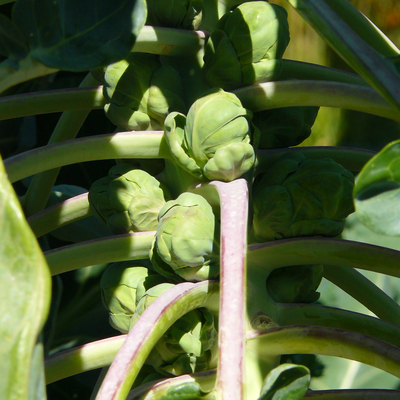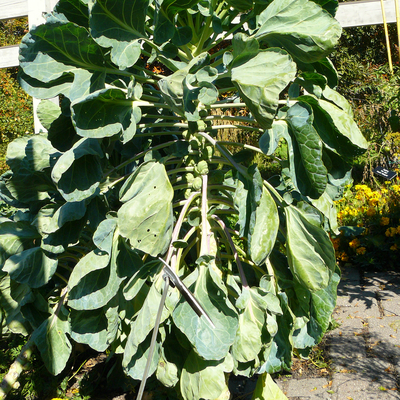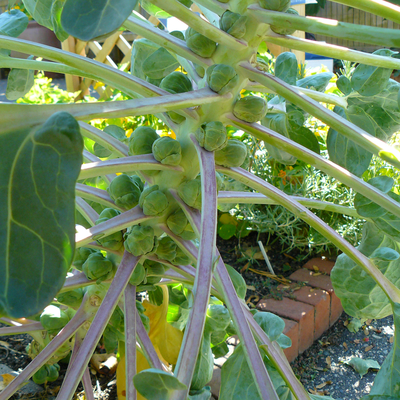A quick guide to Brussels sprouts
- Brussels sprouts are a fall crop in Minnesota.
- Sow seeds in June, indoors or directly in the garden.
- Water thoroughly once a week for well-formed, large, sweet sprouts.
- They can stay in the garden as long as temperatures remain above 20°F.
Flavorful winter vegetables
Brussels sprouts (Brassica oleracea var. gemmifera) are tight heads of tender leaves, like mini cabbages, grown on the stalk of a tall, leafy plant. The large leaves are smooth and thick and resemble collard greens; you can prepare them in the same ways.
Where each leaf joins the stem, a small sprout develops, beginning with the lowest leaves and continuing up the stalk. The sprouts can be as large as two inches in diameter, but gardeners often harvest them when they are smaller.
Grown as a fall crop in Minnesota, Brussels sprouts are one of the few crops usually harvested after snow has fallen. Flavor improves with cooler fall weather; they can stay in the garden as long as temperatures remain above 20°F.
Since they must mature in cool weather for good quality, plan to harvest from late September in the north, through late October in the southern part of the state and along the Lake Superior shoreline.
Soil pH and fertility
- Have your soil tested.
- Grow Brussels sprouts in well-drained yet moisture-retentive, fertile soil with pH of 6 to 7.
- Apply phosphorus (P) and potassium (K) according to soil test recommendations. Many Minnesota soils have enough phosphorus.
- Unless your soil test report specifically recommends additional phosphorus, use a low- or no-phosphorus fertilizer.
- The plants need to take up water and nutrients throughout their growth.
- Improve your soil by adding well-rotted manure or compost in spring or fall. Do not use fresh manure as it may contain harmful bacteria, and may increase weed problems.
- Side-dress when the plants are about four inches tall.
- Do not use any fertilizer containing a weed killer ("Weed and Feed"), as it may kill your vegetable plants.
Planting
Sow seeds indoors in June.
- Use sterile soilless seedling mix and press the seeds ¼ to ½ inch deep.
- Do not use bottom heat. The seeds will germinate and the plants will grow well in regular summer temperatures.
- Seeds should germinate in about two weeks. Once the seedlings emerge, turn on bright grow lights above them.
- Apply fertilizer to developing seedlings beginning when the first true leaf appears. Use a half-strength starter solution once a week. After two true leaves are present, apply fertilizer twice a week.
- When the plants display four or five true leaves after about three weeks, reduce watering. Place plants outside where they will receive wind protection and a couple hours of sunlight.
- Gradually expose them to more sunlight and wind over the next week, being sure to keep them well-watered.
- Dig small holes with a trowel, or dig a furrow with a shovel. Place the seedlings 18 inches apart, and fill the soil around them so that the plant is at the same level it was in its pot.
- Water the plants in, or use a transplant starter solution high in phosphorus and low in nitrogen and potassium.
Brussels sprout seedlings have the distinct appearance of seedlings in the mustard family. The first two leaves to sprout, called “cotyledons,” are fleshy and shaped like capital “Bs”. True leaves follow these cotyledons.
You will need to take particular care of the seedlings. They are most vulnerable when exposed to extreme heat, wind, drought and insects. Water seedlings as needed.
Direct-seeded plants will need as much as three weeks more to mature than plants started indoors, so gardeners in northern Minnesota should use transplants.
Plant seed shallowly (1/4 to 1/2 inch), dropping three seeds every 18 inches. Once the plants emerge, thin so that there is one seedling every 18 inches. Keep the soil moist during emergence.
A row cover will protect the plants from wind and insects during the first weeks of growth. Use a lightweight material so that temperatures do not get too hot under the cover.
If strong winds loosen a floating row cover, it can do more damage than the plants would suffer without it, so be sure to anchor it firmly with soil and/or pins at the edges. You can also support the row cover with wire hoops
How to keep your Brussels sprouts healthy and productive
-
Brussels sprouts demand good soil moisture.
-
To produce tender, tightly wrapped, sweet, and good-flavored sprouts the plants must receive consistent rainfall or irrigation. If they do not they will have loose, poorly developed sprouts, poor texture and too much bitterness.
-
If the planting does not receive one inch of rain each week, soak the soil thoroughly at least once a week.
-
If your soil is sandy, it is important to water more than once a week.
-
An inch of water will wet a sandy soil to a depth of ten inches, a heavy clay soil to six inches.
-
Use a trowel to see how far down the soil is wet. If it is only an inch or two, keep the water running.
- Frequent, shallow digging with a hoe or trowel will kill weeds before they become a problem.
- Cultivate just deeply enough to cut the weeds off below the surface of the soil. Be careful not to damage the plants when cultivating.
- Mulching with herbicide-free grass clippings, weed-free straw, or other organic material to a depth of three to four inches can help prevent weed from coming up, decreasing the need for frequent cultivation.
- For assistance in diagnosing unknown problems, visit the University of Minnesota Extension diagnostic site “What’s wrong with my plant?”
- A variety of diseases affect Brussels sprouts, including Alternaria leaf spot, black rot, black leg, and clubroot.
- Practice crop rotation. Choose a location in your garden where you have not grown cole crops -- cabbage, cauliflower, broccoli, Brussels sprouts, collards, kale, mustard, turnip, or rutabaga -- for the past four years.
- Even if you have not noticed disease symptoms previously, it is best not to plant cole crops where other plants in the same family have grown recently. Disease spores in the soil can easily infect new plantings.
- Use good cultural control practices to reduce disease problems to a tolerable level and allow for a successful harvest.
Harvest
Brussels sprouts produce many small heads, which form and enlarge from the bottom of the stalk up. When the lowest sprouts are an inch in diameter, you can cut the very top of the plant off. Remove about an inch to two inches at the top of the stalk. This will cause the sprouts at the top to start enlarging as well.
Once the weather has turned cold, with temperatures in the mid-twenties, remove the leaves, cut the plants off at the soil surface, and stack or hang the stalks upright in a cool cellar. Harvest sprouts from the plants over the next few weeks.
You can also cut all the sprouts from the stalks and store them in plastic bags in the refrigerator, where they will keep for up to two weeks.
Storage
You can freeze or pickle Brussels sprouts.
Managing pests and diseases
Many things can affect Brussels sprouts plants. Changes in physical appearance and plant health can be caused by the environment, plant diseases, insects and wildlife. In order to address what you’re seeing, it is important to make a correct diagnosis.
You can find additional help identifying common pest problems by using the online diagnostic tools or by sending a sample to the UMN Plant Disease Diagnostic Clinic. You can use Ask a Master Gardener to share pictures and get input.
Minnesota is home to many common insects that feed on Brussels sprouts. Some level of insect feeding is to be expected.
- Flea beetles chew small holes in leaves. Seedlings are most vulnerable to injury from this feeding.
- Imported cabbage worm, cabbage looper, and diamondback moth larvae feed on the leaves. Young seedlings and transplants are most vulnerable to injury from this feeding.
- Cabbage maggots feed on the roots, injuring the plants, sometimes killing them.
- Swede midge is a new pest in Minnesota that can cause brussel sprout plants to become scarred and distorted.
- As sprouts develop, aphids can often be found feeding within the sprouts.
- If you have aphids, you may see natural enemies nearby feeding on them.
Many of the same cultural practices help prevent a wide variety of Brussels sprout diseases.
- Alternaria is a common disease that causes spots on leaves.
- Black rot causes yellow triangles on the edge of leaves.
- Clubroot attacks the roots of brussel sprouts, causing roots to be swollen and plants to be stunted.
Reviewed in 2022




